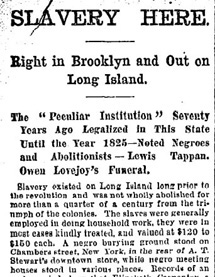 | |||||||||||||
| |||||||||||||
"Slavery Here. Right in Brooklyn and Out on Long Island."Brooklyn Daily EagleBy 1891 when this article was written, only people over the age of 70 would have had a first-hand memory of the institution as it originally existed in Brooklyn. Kings County's Dutch farmers relied heavily on its large slave labor force which the New York State legislature supported by instituting "An Act for the gradual abolition of Slavery" in March 1799. The act provided that any child born to a slave after July 1799 would be considered free. However, to serve the demands of wealthy farmers, the child would remain the servant of the legal owner of his or her mother until, for a male, twenty-eight years of age, and for a female, twenty-five years of age. This law upheld slavery by ascertaining that they would remain slaves until their owner decided to free them. In the early 1800s slaves continued to be traded � in 1802 Robert Benson, whose farmland eventually became Bensonhurst, paid Martin Boerum $75 for Jack, a slave, for a period of three years and fifty-seven days. During this period, Dutch farmers were so reliant on slave labor that Kings County had the highest proportion of slaveholders and slaves in the North. Between 1800 and 1820, as Brooklyn became more industrialized, the number of slaves fell by 57 percent, but only by 19 percent in the mostly agricultural area of Flatlands. (Linder and Zacharias, Of Cabbages and Kings County, Agriculture and the Formation of Modern Brooklyn, pp. 80-82.) The gradual and reluctant manumission of slaves over the first quarter of the 19th century ended with the 1827 law abolishing slavery in New York State. Many freedmen remained in Brooklyn, working for the same families that had enslaved them, or becoming fishermen on the coast, or working as a laborer in Brooklyn or Manhattan. While the present article claims that slaves were in most cases treated kindly, another, dated November 17, 1878, paints a less rosy picture of slave life on Long Island. To read the entire Brooklyn Daily Eagle article, click here: "Slavery Here: Right in Brooklyn and Out on Long Island" (December 29, 1891). Citation - Document 100 Additional Documents:
|
|||||||||||||
